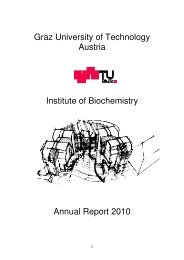Staff Members of the Institute of Biochemistry, TU - Institut für ...
Staff Members of the Institute of Biochemistry, TU - Institut für ...
Staff Members of the Institute of Biochemistry, TU - Institut für ...
Create successful ePaper yourself
Turn your PDF publications into a flip-book with our unique Google optimized e-Paper software.
investigated <strong>the</strong> effect <strong>of</strong> squalene on biophysical properties <strong>of</strong> lipid particles and membranes<br />
and compared <strong>the</strong>se results to artificial membranes. Our experiments showed that squalene<br />
lowered <strong>the</strong> order <strong>of</strong> SE which form concentric shells in lipid droplets from wild type. In<br />
biological and artificial membranes fluorescence spectroscopy studies revealed that changes<br />
in membrane fluidity/rigidity are not result <strong>of</strong> absolute squalene levels, but are ra<strong>the</strong>r affected<br />
by <strong>the</strong> squalene to ergosterol ratio. In a fluid membrane environment squalene induces rigidity<br />
<strong>of</strong> <strong>the</strong> membrane, whereas in rigid membrane <strong>the</strong>re is almost no additive effect <strong>of</strong> squalene.<br />
Although squalene is not a typical membrane lipid it may be regarded as a mild modulator <strong>of</strong><br />
biophysical membrane properties.<br />
Pichia pastoris organelles and lipids<br />
Doctoral Thesis completed<br />
Miroslava Spanova: Neutral Lipid Storage in Yeast<br />
The yeast Pichia pastoris is an important experimental<br />
system for heterologous expression <strong>of</strong> proteins.<br />
Never<strong>the</strong>less, surprisingly little is known about organelles <strong>of</strong><br />
this microorganism. For this reason, we started a systematic<br />
biochemical and cell biological study to establish<br />
standardized methods <strong>of</strong> Pichia pastoris organelle isolation<br />
and characterization. Recent work focused on <strong>the</strong><br />
biochemical characterization <strong>of</strong> <strong>the</strong> plasma membrane and<br />
secretory organelles from Pichia pastoris. Moreover, lipid<br />
droplets from Pichia pastoris were isolated and analyzed<br />
with respect to <strong>the</strong>ir lipids and proteins. Mutants bearing<br />
defects in non-polar lipid formation <strong>of</strong> Pichia pastoris were<br />
constructed. Detailed investigations with <strong>the</strong>se strains are<br />
currently in progress. Methods <strong>of</strong> Pichia pastoris organelle<br />
characterization include standardized techniques <strong>of</strong> lipidome<br />
and proteome analyses.<br />
Transmission electron micrographs <strong>of</strong> Pichia pastoris wild<br />
type cells grown on glucose (A), glycerol (B), and methanol<br />
(C). Pictures shown be courtesy <strong>of</strong> Dr. G. Zellnig, University<br />
<strong>of</strong> Graz, Austria<br />
Squalene, a natural triterpene, is a key intermediate in ergosterol syn<strong>the</strong>sis <strong>of</strong> <strong>the</strong> yeast and<br />
present in <strong>the</strong> cell only at minor amounts under standard conditions. For <strong>the</strong> present study we<br />
constructed strains <strong>of</strong> Saccharomyces cerevisiae accumulating squalene to perform<br />
fundamental research but also as a possible source for biotechnological production <strong>of</strong> this<br />
lipid. We first addressed localization <strong>of</strong> squalene within <strong>the</strong> cell and its possible lipotoxic<br />
effect in <strong>the</strong> yeast. We showed that <strong>the</strong> highly hydrophobic squalene preferentially localizes to<br />
lipid particles/droplets. In this compartment it decreases <strong>the</strong> order which is created by steryl<br />
esters forming concentric layers around a core <strong>of</strong> triacylglycerols. We also observed that<br />
squalene did not exhibit a lipotoxic effect even in mutant strains which are unable to form<br />
lipid particles. In strains devoid <strong>of</strong> lipid particles large amounts <strong>of</strong> squalene were stored in<br />
20














